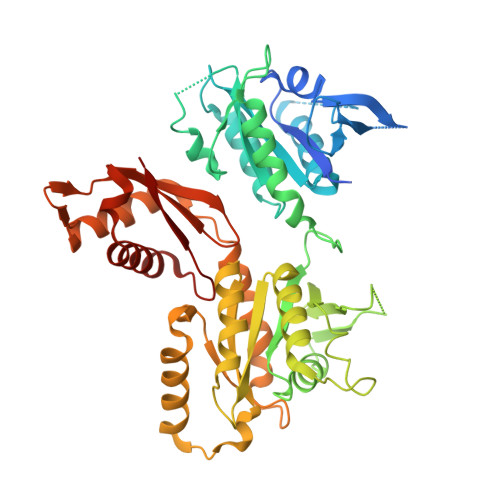Potassium Acts as a GTPase-Activating Element on Each Nucleotide-Binding Domain of the Essential Bacillus subtilis EngA.
Foucher, A.E., Reiser, J.B., Ebel, C., Housset, D., Jault, J.M.(2012) PLoS One 7: e46795-e46795
- PubMed: 23056455
- DOI: https://doi.org/10.1371/journal.pone.0046795
- Primary Citation of Related Structures:
4DCS, 4DCT, 4DCU, 4DCV - PubMed Abstract:
EngA proteins form a unique family of bacterial GTPases with two GTP-binding domains in tandem, namely GD1 and GD2, followed by a KH (K-homology) domain. They have been shown to interact with the bacterial ribosome and to be involved in its biogenesis. Most prokaryotic EngA possess a high GTPase activity in contrast to eukaryotic GTPases that act mainly as molecular switches. Here, we have purified and characterized the GTPase activity of the Bacillus subtilis EngA and two shortened EngA variants that only contain GD1 or GD2-KH. Interestingly, the GTPase activity of GD1 alone is similar to that of the whole EngA, whereas GD2-KH has a 150-fold lower GTPase activity. At physiological concentration, potassium strongly stimulates the GTPase activity of each protein construct. Interestingly, it affects neither the affinities for nucleotides nor the monomeric status of EngA or the GD1 domain. Thus, potassium likely acts as a chemical GTPase-activating element as proposed for another bacterial GTPase like MnmE. However, unlike MnmE, potassium does not promote dimerization of EngA. In addition, we solved two crystal structures of full-length EngA. One of them contained for the first time a GTP-like analogue bound to GD2 while GD1 was free. Surprisingly, its overall fold was similar to a previously solved structure with GDP bound to both sites. Our data indicate that a significant structural change must occur upon K(+) binding to GD2, and a comparison with T. maritima EngA and MnmE structures allowed us to propose a model explaining the chemical basis for the different GTPase activities of GD1 and GD2.
Organizational Affiliation:
Institut de Biologie Structurale, Université Joseph Fourier Grenoble 1, Grenoble, France.




















